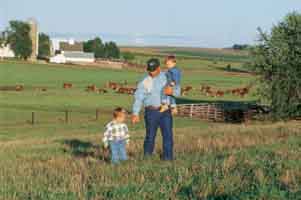
Agricultural News
What's in a word? USDA's Definition of Farmer Raises Hackles and Concerns
Fri, 15 Feb 2013 08:33:56 CST

Writing in Farm Policy Facts, Rene Pastor tackles misconceptions about what constitutes a farm.
It seems simple enough. What is a farm?
The U.S. Agriculture Department (USDA) defines it as "any place from which $1,000 or more of agricultural products were produced and sold, or normally would have been sold, during the year."
"Very large farms" are defined as having gross sales of more than $500,000.
Sounds straightforward, but the entire picture is a bit more nuanced and far more complicated.
"Definitions are used for statistical purposes, but do not adequately define what family farms are," said Jerry McReynolds, a wheat farmer and stockman from the northern part of Kansas, the top wheat growing state in the country accounting for up to a fifth of total U.S. production.
"In fact, almost 95 percent of all U.S. farms are family owned," Darren Hudson, the director of the Cotton Economic Research Institute at Texas Tech University in Lubbock, Texas, told Farm Policy Facts in a separate interview.
Based on the way the USDA defines big farms, one would think many farmers are raking it in. But if you have $500,000 in sales but $450,000 in expenses and taxes, the farmer's family would be living on $50,000 per year.
Not exactly the payday of a corporate giant, explained McReynolds."The rate of return (for farmers) has historically been low on the investment involved," he added.
Unfortunately for McReynolds and other farmers, the figures and definitions used by the U.S. government continue to be twisted as a way to attack the farm policies on which they depend.
For example, agriculture opponents can say most farm policy benefits go to just 10 percent of farmers because the official threshold for farm categorization is so low.
Under the $1,000 definition of agricultural products used by the USDA, there are 2.1 million farms in a nation made up of nearly 320 million people.
Of that total, most are part-time or hobby farmers who don't raise food commercially. The nation depends on the 210,000 farmers with sales of more than $250,000 to produce 80 percent of the country's food and fiber.
Saying that most farm policy benefits go to supporting 80 percent of the country's food and fiber supply doesn't sound nearly as damning.
Hudson said that despite vigorous attempts by the USDA "to try and better categorize farms according to size, income, etc., to counter critiques, problems can still arise."
"The reality is that people primarily misunderstand the nature of the data," he said. "For example, a 1,500-acre cotton farm will typically generate over $1 million in sales, thereby being classified as a 'large' farm in USDA's data. But, profitability on that is less than a much smaller corn farm. So, sales can be a misleading indicator because it fails to account for variations in costs of production."
Sharon Johnson, a senior cotton market analyst with Knight Futures in Atlanta, Ga., pointed to another issue.
"Producers have huge costs. Some of the large equipment they buy can cost $500,000 to $1 million each," she explained.
Some farm leaders hope USDA can refine its definitions and language so it can provide a more accurate snapshot.
Hudson said one way to do so would be for the USDA to report on items "like rates of return on assets as opposed to just sales (which) would be helpful to put it in perspective with other industries."
Taking that step would help show that farmers have a narrow margin with which to fend off years when natural disasters like withering drought or serious flooding strike.
"I think people would be shocked at the long-term rate of return in agriculture compared with other industries," Hudson said.
McReynolds said Americans are generally supportive of farmers, especially if they are shown the struggles they go through to make the country largely self-sufficient in basic foodstuffs.
"Farmers are trying to provide for their families and others. They are passionate about what they do, work tirelessly and carry more risk than most business would be willing to carry. It is a great life, but not always a great living," he concluded.
WebReadyTM Powered by WireReady® NSI
Top Agricultural News
More Headlines...




















